Driven by a need to upgrade milking facilities and reduce dependence on labor, three different dairy farms opted for automated milking.
These dairymen and a provider of this technology discussed their implementation strategies and herd improvements during a panel discussion titled “People, Cows and Tech: Tips for Implementing Automation to Maximize Efficiency” at the virtual California Dairy Sustainability Summit in November.
Deciding on robots
The Postma family exhausted their flat barn after milking approximately 1,200 cows through the 14-stall California walkthrough for almost 20 years.
“When you’ve got a welder in the milk barn every day fixing stuff and whatnot, and guys complaining, and trying to find guys to stay in that sort of a barn, you get pretty frustrated,” said Jonathon Postma, who farms with his father and brother in Modesto, California.
The Postmas were first introduced to automation in 2013 when their equipment dealer brought over some Lely cow brushes.
Still, they heavily considered building a new rotary parlor until they boarded an airplane to tour a variety of robot farms from different manufacturers to new construction versus retrofit.
“Just watching it, everything worked. We kind of knew that was the direction that we wanted to head from that point on,” Postma said.
“We knew that labor was going to be probably our biggest factor. Labor has just gotten harder and harder and more and more expensive. ... This gave us an opportunity to be able to dairy in a different way with some different types of efficiencies,” he said.
This was a driving factor for David Jones as well. “We needed to find a way to dairy on our farm with less labor input,” he said, noting labor issues had become an everyday occurrence on his family’s 800-cow dairy in Stevinson, California.
The Joneses were looking to replace their flat barn as well. They set aside the plans they had for a parallel parlor and started looking at robots.
Lack of available labor led the initiative, but “when you’re touring, and you start to see all of the great benefits for the cows, it really makes it very attractive to want to implement the technology on your own herd,” Jones said.
That’s what caught Greg Hooker’s eye when he happened to tour a robotic facility.
“It’s very intriguing from an efficiency standpoint, from a labor standpoint, from a cow comfort standpoint,” Hooker said. “It was just kind of a fascinating process to see happen.”
He wasn’t struggling with labor on his 4,500-cow dairy near Chowchilla, California, but could see the writing on the wall. “Nobody wants to milk cows for eight to 10 hours a day, and I don’t blame them,” Hooker said.
“Just like in a lot of industries, there’s those repetitive jobs, monotonous jobs; they get replaced by automation. I think this just is going in that direction as well,” he added.
Driven by an opportunity to expand his herd, Hooker had been looking at rotaries but ultimately liked how robots would allow expansion at a slower rate.
Hooker and his two sons are initially installing 13 robots, with plans in place that could expand up to 36 robots total in the facility.
“By doing these modular robots, [you can] basically grow at a slower speed, and add cows, either as you can afford them, or as they come in the barn, or as opportunity presents itself,” Hooker said.
Transitioning to robots
There are two groups that need to adjust to the robots – cows and people.
“Every cow is different,” Postma said, noting some adapt right away and others will fight it.
In his experience, Postma was highly questioning their decision on the first day – but after a few months, the cows were doing fairly well.
“Ultimately, I think, when a cow really starts to excel is when it calves back into the herd,” he said. “It’s like riding a bike; these cows go dry for a period of time and come back and they’re raring and ready to go.”
In their retrofit project, Jones said they were able run cows through the box to get them comfortable with it before it was fully operational. They also started feeding a pound of grain or less at the robot.
“By the time we started up, we already had 60 percent of the cows visiting the robots on their own time,” he said. “That was a huge benefit to us, and it made our startup a lot easier.”
Now when they introduce a new cow to the robot, they spend four days fetching the cows four times a day.
“We know that their visits over time are going to drop off, so if we start at 4X, typically we can maintain an average of three throughout the lactation,” Jones said. “That’s been our strategy, and it’s been working well.”
Hooker planned to be very selective with the first 200 cows to enter the robotic milking string.
“If a cow doesn’t acclimate to a robot, we can send her back to the traditional barn,” he said, hoping for some efficiencies in not having to deal with any outliers.
He spent a lot of time in design and building to make sure the facility allows for efficiency in labor and cow flow to and from the robots.
“I’ve done several expansions over the years and, by far, this one took the most time. It was a daily basis working with a contractor and figuring out where things go, how things are supposed to work, and what the best way to lay things out are,” Hooker said.
During the construction phase is when John Paetz, a regional sales manager with Lely North America, starts working with the people of the operation.
“We want to make sure that in a robot dairy, everybody understands we’re managing cows by exception,” Paetz said.
Instead of locking up a large group to find a few, the robot will sort those few cows that need attention. “We’re not doing batch management tasks,” he said. “We’re not doing preg checks on Tuesday; it’s an everyday thing.”
“It’s a pretty steep learning curve,” Jones added. “My biggest challenge as an operator was getting out of my own way.”
He fought the urge to fetch cows the minute they were overdue for milking and learned to trust the system. “We found that the less that we were actually in those pens, the better the cows tended to perform,” Jones said.
He also found training and standard operating procedures (SOPs) for employees to follow to be important in minimizing the gray areas of a new management system.
The Postmas learned personality plays a big role in working in a robot barn. They identified a couple of employees that didn’t have the skill set assumed for robots, but after being shown what to do and how to do it for about a week, they were able to pick up on what was needed in the role. Now they can check the software program, tear down the equipment and fix most problems that arise.
“I firmly believe that as long as you have the right personality in that barn, anybody can work in a robot facility,” Postma said.
Performance results
The Postmas milk about 600 of their 2,200 cows with 10 robots and the rest conventional 2X. They saw an increase in milk production as the cows in robots increased to 2.8 milkings per day. Postma also credits the more customized feeding program and stress-free barn environment for the added production.
Jones compared his robot strings to his conventional herd and found first-lactation animals to be 10 pounds higher in milk and the second-lactation-and-greater cows to be 12 to 15 pounds higher in milk.
“Most of that is the robotic effect, bringing the parlor to the cow, eliminating that holding pen time,” he said.
Paetz added, “The disclaimer that I tell every potential robot user is that robots don’t make milk, they harvest milk. What does make milk ... is that lack of stress.”
The stress reduction has also impacted reproduction rates with one less service per conception and a higher pregnancy rate for Jones’ robot strings.
Both Postma and Jones reported no difference in milk quality between their robotic and conventional herds, and are seeing good things with overall herd health in their robotic milking facilities.
Postma noted fewer hoof problems because the cows aren’t on their feet as long.
“Overall, I think you’ll see at least another half-lactation, if not a whole,” Postma said of cows in a robotic facility. “That’s a significant amount of money in today’s day and age. ...The longer we can keep them around, the quicker you’re going to get that robot paid for.”
Jones said they are seeing about a 7% reduction in their involuntary cull rate with the robotic animals and an additional lactation in their records of productive life on those animals. “It’s been pretty incredible just what the reduction of stress can do,” he said.
“It’s not so much to do with a robot, but just the environment they’re in,” Paetz said. “I think people go into robots for labor or for other financial gain, and what they see is whole-cow benefit.”
This is what Hooker hopes to gain as his experience with robots gets underway. “All of these metrics play a key role in the economics of it as well. It is a labor-saving technology, but really where the rubber meets the road is in production and longevity. Those numbers actually impact the bottom line almost more than what the labor portion of the equation comes to,” Hooker said.






